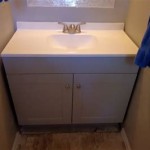Can You Replace a Single Bathroom Tile?
A single cracked or damaged bathroom tile can drastically detract from the overall aesthetic of your bathroom. While a complete bathroom remodel may seem like the only solution, replacing a single tile is often a feasible and budget-friendly option. This article will guide you through the process of replacing a single bathroom tile, outlining the necessary steps and tools to complete the project successfully.
Assessing the Situation
Before embarking on the tile replacement process, it's crucial to assess the situation. Some factors to consider include:
- The type of tile: Different types of tiles require different techniques and tools for removal and replacement.
- The location of the tile: A tile in a high-traffic area, such as the shower floor, may require more care during removal.
- The extent of the damage: A single crack may be easily replaced, while a severely damaged tile might require additional repairs.
- The condition of the surrounding grout: If the grout is cracked or damaged, it may need to be replaced along with the tile.
Tools and Materials
To successfully replace a single bathroom tile, you will need the following tools and materials:
- Safety goggles: To protect your eyes from flying debris.
- Work gloves: To protect your hands from sharp edges.
- Chisel and hammer: To remove the damaged tile.
- Tile saw or wet saw: To cut the replacement tile to size.
- Grout removal tool: To remove the old grout.
- Bucket and sponge: To clean the area before and after installation.
- Thin-set mortar: To adhere the new tile to the substrate.
- Grout: To fill in the gaps between tiles.
- Grout float: To apply and smooth the grout.
- New tile: Matching or complementary to the existing tiles.
Replacing the Tile
Once you have gathered the necessary tools and materials, you can proceed with the tile replacement process. The following steps provide a general guide:
- Prepare the work area: Clear the area around the damaged tile and protect surrounding surfaces from debris.
- Remove the old grout: Use a grout removal tool to carefully remove the grout around the damaged tile. Be mindful not to damage the surrounding tiles during this process.
- Remove the damaged tile: Use the chisel and hammer to gently break the damaged tile into smaller pieces. Work your way around the tile, chipping it away until it is completely removed. Be cautious not to damage the surrounding tiles or the underlying substrate.
- Prepare the substrate: Clean the area where the new tile will be installed. Ensure the surface is smooth, clean, and free of debris. This will improve the adhesion of the thin-set mortar.
- Cut the new tile: If necessary, use a tile saw or wet saw to cut the new tile to the appropriate size and shape to fit the space. Ensure that the new tile is the same thickness as the original tile.
- Apply thin-set mortar: Spread a thin layer of thin-set mortar onto the prepared substrate using a trowel. The thickness of the mortar should be consistent for optimal adhesion.
- Install the new tile: Carefully position the new tile onto the thin-set mortar. Press down firmly to ensure a secure bond.
- Clean up excess mortar: Wipe away any excess mortar from the tile surface using a damp sponge. This will prevent the mortar from hardening and ruining the aesthetics of the tile.
- Allow the mortar to cure: Follow the manufacturer's instructions for curing time. This usually takes 24-48 hours. Do not walk on the tile or apply any pressure to the new tile until the mortar has fully cured.
- Apply grout: Once the mortar has cured, apply grout to the gaps between the tiles using a grout float. Wipe away excess grout with a damp sponge to ensure a smooth and even finish.
- Seal the grout: Once the grout has cured, apply a sealant to protect the grout from stains and moisture.
Important Considerations
While replacing a single bathroom tile may seem like a simple task, there are several crucial considerations to keep in mind:
- Matching the tile: If you are replacing a tile in an existing installation, selecting a matching tile is essential. While finding an exact match can be challenging, especially for older tiles, try to find a tile with similar color, texture, and size as the existing ones.
- Safety precautions: Take necessary safety precautions during the project, including wearing safety goggles and work gloves to protect yourself from flying debris and sharp edges. Use caution when handling power tools and ensure the work area is well-ventilated.
- Patience and precision: Replacing a single tile requires patience and precision to ensure a seamless finished product. Take your time and follow the steps carefully to avoid mistakes. Be sure to consult with a professional if you are unsure about any part of the process.
Replacing a single bathroom tile can be a rewarding DIY project, allowing you to update the aesthetic of your bathroom without the expense and disruption of a full remodel. By carefully following the steps outlined in this article, you can achieve a professional-looking finish.

How To Remove Replace One Bathroom Tile Ceramic Repair

How To Upgrade Bathroom Tile Without Replacing

Can You Reuse Ceramic Tile

How To Replace A Broken Tile

At Home Repairing Bathroom Tiles Can Be A Challenge

How To Tile Over Tiles And Save Time Money

How To Cover Wall Tile Without Removing Them In Bathrooms

Can You Install Tile Over Here S What The Experts Say

9 Tips For Mixing And Matching Tile Styles

How To Replace A Ed Tile
Related Posts







